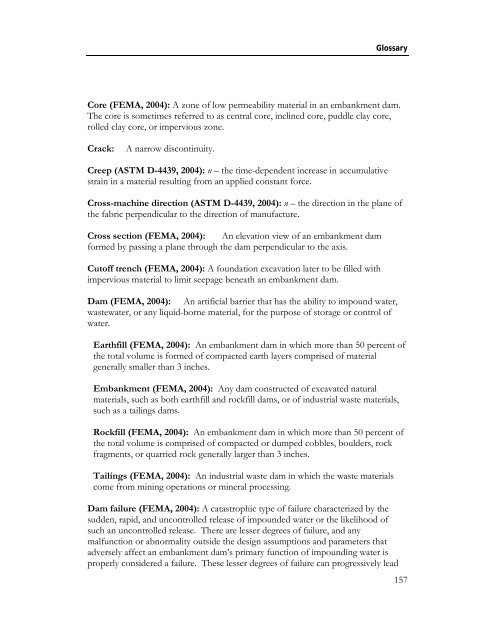Geotextiles in Embankment Dams - Association of State Dam Safety ...
Geotextiles in Embankment Dams - Association of State Dam Safety ...
Geotextiles in Embankment Dams - Association of State Dam Safety ...
You also want an ePaper? Increase the reach of your titles
YUMPU automatically turns print PDFs into web optimized ePapers that Google loves.
GlossaryCore (FEMA, 2004): A zone <strong>of</strong> low permeability material <strong>in</strong> an embankment dam.The core is sometimes referred to as central core, <strong>in</strong>cl<strong>in</strong>ed core, puddle clay core,rolled clay core, or impervious zone.Crack:A narrow discont<strong>in</strong>uity.Creep (ASTM D-4439, 2004): n – the time-dependent <strong>in</strong>crease <strong>in</strong> accumulativestra<strong>in</strong> <strong>in</strong> a material result<strong>in</strong>g from an applied constant force.Cross-mach<strong>in</strong>e direction (ASTM D-4439, 2004): n – the direction <strong>in</strong> the plane <strong>of</strong>the fabric perpendicular to the direction <strong>of</strong> manufacture.Cross section (FEMA, 2004): An elevation view <strong>of</strong> an embankment damformed by pass<strong>in</strong>g a plane through the dam perpendicular to the axis.Cut<strong>of</strong>f trench (FEMA, 2004): A foundation excavation later to be filled withimpervious material to limit seepage beneath an embankment dam.<strong>Dam</strong> (FEMA, 2004): An artificial barrier that has the ability to impound water,wastewater, or any liquid-borne material, for the purpose <strong>of</strong> storage or control <strong>of</strong>water.Earthfill (FEMA, 2004): An embankment dam <strong>in</strong> which more than 50 percent <strong>of</strong>the total volume is formed <strong>of</strong> compacted earth layers comprised <strong>of</strong> materialgenerally smaller than 3 <strong>in</strong>ches.<strong>Embankment</strong> (FEMA, 2004): Any dam constructed <strong>of</strong> excavated naturalmaterials, such as both earthfill and rockfill dams, or <strong>of</strong> <strong>in</strong>dustrial waste materials,such as a tail<strong>in</strong>gs dams.Rockfill (FEMA, 2004): An embankment dam <strong>in</strong> which more than 50 percent <strong>of</strong>the total volume is comprised <strong>of</strong> compacted or dumped cobbles, boulders, rockfragments, or quarried rock generally larger than 3 <strong>in</strong>ches.Tail<strong>in</strong>gs (FEMA, 2004): An <strong>in</strong>dustrial waste dam <strong>in</strong> which the waste materialscome from m<strong>in</strong><strong>in</strong>g operations or m<strong>in</strong>eral process<strong>in</strong>g.<strong>Dam</strong> failure (FEMA, 2004): A catastrophic type <strong>of</strong> failure characterized by thesudden, rapid, and uncontrolled release <strong>of</strong> impounded water or the likelihood <strong>of</strong>such an uncontrolled release. There are lesser degrees <strong>of</strong> failure, and anymalfunction or abnormality outside the design assumptions and parameters thatadversely affect an embankment dam’s primary function <strong>of</strong> impound<strong>in</strong>g water isproperly considered a failure. These lesser degrees <strong>of</strong> failure can progressively lead157
















